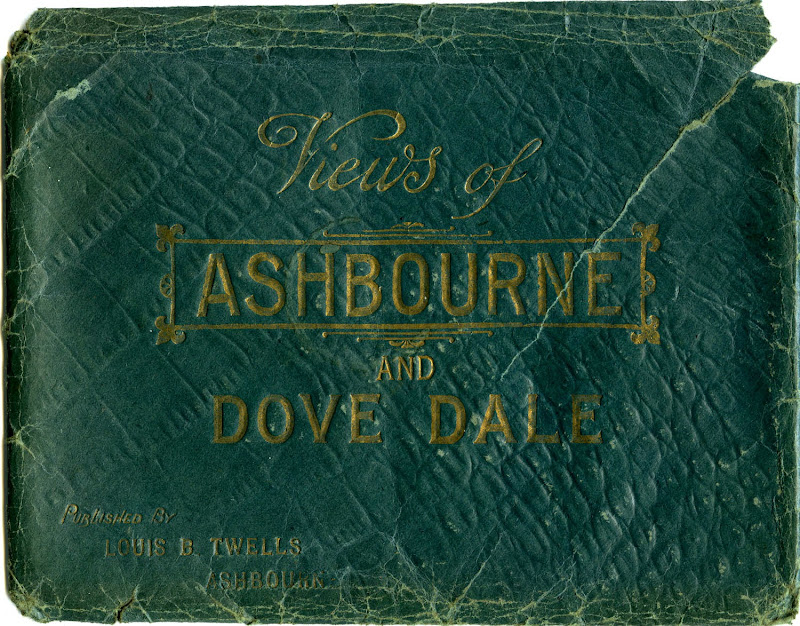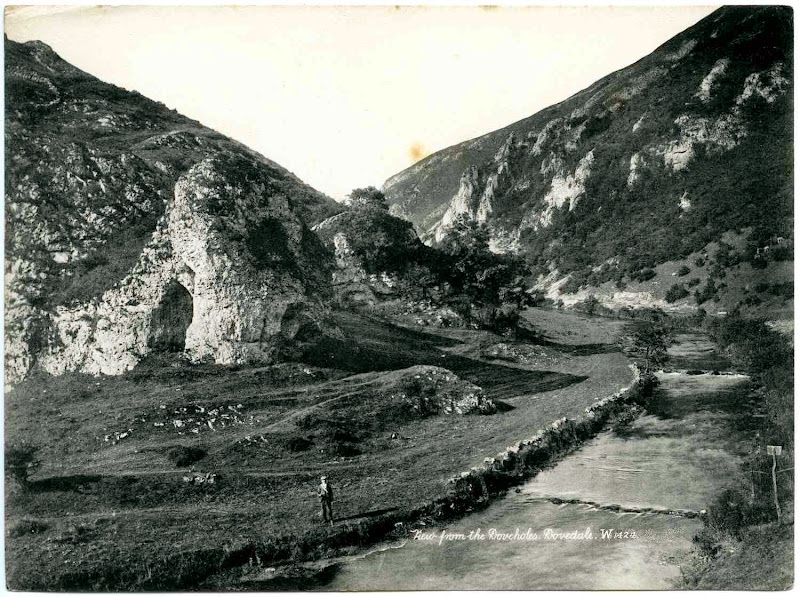
This week's Sepia Saturday theme image of a buther's shopfront is a reminder, if we ever needed one, of now much our townscapes have changed in the last century, and by that I'm referring not just to the buildings themselves but also the nature of the window displays and manner of presenting wares to the public. Attractive as they are to the modern tourist, most of the quaint old historic villages that one sees regularly in guide books and on the television bear little resemblance to how they looked in Victorian times. There are some exceptions, however, and some time fellow Sepian Nigel Aspdin has kindly dropped whatever he was doing, hopped on the bus at a moments notice, and spent a rainy morning in Ashbourne (Derbyshire) taking some "now" photos for me.

Green Man Hotel. Ashbourne. W.4286
Lithographic print of photograph by unknown photographer
Published by Louis B. Twells, Ashbourne, probably c.1885-1895
Image © and collection of Brett Payne
Consider this image of the Green Man and Black's Head Royal Hotel in the medieval market town of Ashbourne in the Derbyshire Dales, which was published by photographer Louis B. Twells, probably in the mid-1880s to early 1890s. A crowd of onlookers has assembled in the archway of the inn's carriage entrance, either to provide a send off for the distinguished looking family departing in the horse-drawn carriage, or at the photographer's bidding to provide some life in his scene. Plenty of human interest there certainly is in this well constructed and executed view, with a gaggle of children lurking on the street corner, a couple of erstwhile shoppers walking down the pavment at far left, perhaps having just visited Henry Hood & Son's tailors and gentleman's outfitters shop next door to the Green Man.

Green Man Hotel, St John Street, Ashbourne, 13 July 2015
Image © and courtesy of Nigel Aspdin
Mrs. Fanny Wallis was proprietress of the Green Man and Black's Head Commercial and Family Hotel, Posting House & Inland Revenue Office (to quote its full title as given in trade directories of the time) in St John Street, Ashbourne from the death of her husband Robert Wallis in 1871 until her own death in 1898. Little appears to have been done to the exterior since then, and the outfitter's next door is somewhat surprisingly still selling clothing. They have, however, cleaned up the horse droppings on the road.

Market Square. Ashbourne. W.4285
Lithographic print of photograph by unknown photographer
Published by Louis B. Twells, Ashbourne, probably c.1885-1895
Image © and collection of Brett Payne
Nigel's great-grandfather William Barnes had an ironmonger's shop fronting onto Market Place, and used the full extent of the open area to display his wares, presumably by arrangement with the authorities to avoid a fine for obstructing the pavement. His sign in the middle of the square is just visible near the right hand edge of this scene, partly obscuring the shop front of George Hill & Company, boot and shoe manufacturers. The building to the left of this was occupied by the Conservative Club (John Rowland, secretary). The only other sign clearly legible, and reading only "Bradley," is affixed to a building at middle left, actually situated on St John Street. This was, according to the 1891 edition of Kelly's Trade Directory, Edwin Sylvester Bradley, chemist and druggist. The directory also provides the following:
A handsome monument and fountain was erected in the market place in 1873, by public subscription, in memory of the late Francis Wright esq. of Osmaston Manor, for his valuable services to the town and neighbourhood.

Market Square, Ashbourne, 13 July 2015
Image © and courtesy of Nigel Aspdin
The monument is still there, although by now somewhat darker than the surroundings, and William Barnes' agricultural implements have been replaced, inveitably, by motor vehicles. Otherwise, the general outline of buildings and skyline remain almost completely unchanged, although I did notice that the top spike is missing from a finial on a building facade at the far left, perhaps knocked off by an over-exuberant spectator or player during one of Ashbourne's annual Royal Shrovetide Tuesday Football games. The then Prince of Wales (future Kind Edward VIII) received a bloody nose during the 1928 match.

Market Square, Ashbourne, 13 July 2015
Image © and courtesy of Nigel Aspdin
William Barnes' shop front is not visible in the lithographic view, but can be seen in Nigel's recent photo, now occupied by the Lighthouse charity shop and Spar and looking rather sad, in my view.

Church Street. Ashbourne. W.2669
Lithographic print of photograph by unknown photographer
Published by Louis B. Twells, Ashbourne, probably c.1885-1895
Image © and collection of Brett Payne
In this view of Church Street, which becomes St John Street further down in the vicinity of The Green Man, the streetscape is full of people standing chatting outside shops and, in the case of several blurred figures, walking along the pavement. I've been unable to decipher the name of the shop outside which the three young men are loitering at left, but the shop window looks to be full of bottles. On the right hand side of the street, the wrought iron sign for the White Hart Hotel (Mrs Elizabeth Burton, proprietor) is just visible, although the writing not legible.

Church Street, Ashbourne, 13 July 2015
Image © and courtesy of Nigel Aspdin
The modern day bunting-bedecked view shows the bottle shop at left to be occupied by Fidler Taylor, estate agents, valuers, surveyors and auctioneers; the bottles have gone. There is no longer and parking for vehicles at the kerb, whether horse-drawn or motorised, but there are roughly the same number of pedestrians and the White Hart Hotel now offers Sky Sports Live - I shan't be going in there any time soon.

Grammar School. Ashbourne. W.4284
Lithographic print of photograph by unknown photographer
Published by Louis B. Twells, Ashbourne, probably c.1885-1895
Image © and collection of Brett Payne
Ashbourne's Queen Elizabeth Grammar School looked somewhat dilapidated, perhaps even slightly ghostly, in the late nineteenth century. It was already three hundred years old, and within a couple of decades the teaching programme had moved to a new location on Green Road.

Old Grammar School, Church Street, Ashbourne, 13 July 2015
Image © and courtesy of Nigel Aspdin
The Old Grammar School building has been patched up a little in the ensuing 125 years or so, currently being used as private dwellings, and I notice that it has a "For Sale" sign hanging outside.

Ashbourne Church & Grammar School. 9892. G.W.W.
Lithographic print of photograph by unknown photographer
Published by George Washington Wilson, probably c.1885-1895
Image © and collection of Brett Payne
Diagonally opposite the Old Grammar School on Church Street is the gateway to the Parish Church of St Oswald:
The church of St. Oswald, King and Martyr ... dedicated in 1241 ... is a cruciform building, consisting of chancel, clerestoried nave, south aisle, transept, north and south porches and a central tower, with lofty octagonal spire, 212 feet in height, ribbed with ball flower ornaments and pierced with twenty dormer lights in five tiers of four each; this spire, a work of great beauty and remarkable lightness, is called the "Pride of the Peak," and was restored in 1873.

Ashbourne Church. 3918. G.W.W.
Lithographic print of photograph by unknown photographer
Published by George Washington Wilson, probably c.1885-1895
Image © and collection of Brett Payne
A slightly less obstructed and more rural view of the same church but from over the fields to the south was published by the Scottish publisher G.W. Wilson.

Ashbourne Church from the South, 13 July 2015
Image © and courtesy of Nigel Aspdin

Ashbourne Hall. 20,907. G.W.W.
Lithographic print of photograph by unknown photographer
Published by George Washington Wilson, probably c.1885-1895
Image © and collection of Brett Payne
Ashbourne Hall was originally built "somewhat in the style of a French chateau and has still some traces of antiquity."

Ashbourne Hall, 13 July 2015
Image © and courtesy of Nigel Aspdin
The outlying buildings of Ashbourne have not fared so well, this one appearing to have suffered from partial decapitation.

A.R. Bentley, Groceries & Provisions, Ashbourne shop front, 13 July 2015
Image © and courtesy of Nigel Aspdin
Unfortunately I don't have any old photographs of Ashbourne's shopfronts to share with you, but I will include a couple that Nigel took the other day to give you an idea of how it feels to shop in Ashbourne today. Bentley's corner shop probably retains much of the flavour, and perhaps little of the charm, that it had when it first opened in 1973.

Vacant premises, Ashbourne shop front, 13 July 2015
Image © and courtesy of Nigel Aspdin
We have few clues as to what this tenant offered for sale. All I can say now is that they've moved on, hopefully to greener pastures.

Ashbourne shop front, 13 July 2015
Image © and courtesy of Nigel Aspdin
This purveyor of "Home Cooked Meats" and "English & Continental Cheeses" advertising in the windows of perhaps mostly an authentic shop front caters to a boutique market which doesn't appear to be in abundance on this overcast, showery day,

Nigel's, Top Quality Butcher, Ashbourne shop front, 13 July 2015
Image © and courtesy of Nigel Aspdin
Nigel (not my friend Nigel, but another one) may have top quality meat for sale, but I think he needs to brush up on his window dressing skills. A couple of plastic models of a beef and a dairy cow aren't enough to replace the lavish display that his predecessors might have had a century earlier.

J. Morgan's butcher's shop, Broad St, Waterford, Ireland, 25 Feb 1916
Image courtesy of National Library of Ireland's Flickr Commons Collection

Road distance marker, Ashbourne, 13 July 2015
Image © and courtesy of Nigel Aspdin
And if you're interested in where Ashbourne is, I can tell you exactly: 139 miles from London, 45 miles from Manchester, and 13 miles from Derby. Whether you're headed to London, Manchester or Timbuktu, please take a moment to stop off and visit the other Saturday Sepians on the way.
















































